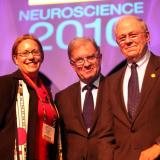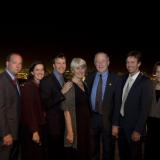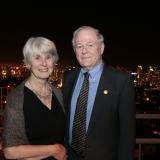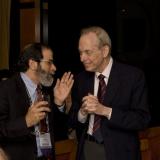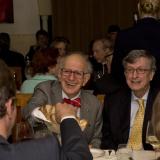2010 Gruber Neuroscience Prize
The pioneering discoveries by neuroscientist Robert H. Wurtz, PhD, on how the brain processes visual information and controls eye movements opened the door to a new field of neuroscience: visual cognition. In 1969, Wurtz published a landmark paper that demonstrated how neurons involved in visual processing in the brain of an awake monkey could be observed and recorded. Using this technique, he went on to make groundbreaking discoveries, including the identification of the visual functions of various areas of the brain and the complex interplay between visual sensation and action in and among these areas. Most current work on visual cognition, including research into such phenomena as attention, motion perception, and motivation, can be traced back to Wurtz’s initial studies. As a result, scientists have a deeper understanding not only of how the brain processes the sensory signals that underlie perception and the control of movement, but also of how those processes go awry in the diseased brain.
2010 Neuroscience Prize Recipient
Laureate Profile
Visual cognition was only a nascent field of neuroscience in 1969, the year that Robert H. Wurtz, PhD, then a physiologist at the National Institute of Mental Health, published a landmark paper in which he demonstrated for the first time how neurons involved in the visual processing of an awake monkey could be observed and recorded. Before then, animals had to be anesthetized to record their neuronal activity—a process that limited what could be studied. Wurtz’s technique (which involved training the monkeys to hold their eyes still for a few seconds while he recorded their neurons as they reacted to moving objects and other visual stimuli) is now used by cognitive neuroscientists around the world and has paved the way for subsequent research on visual cognition, including investigations into such phenomena as attention, motion perception, and motivation.
Wurtz went on to make other groundbreaking discoveries. For example, he mapped the fields of individual neurons in the awake brain that receive visual information. He elucidated how different forebrain structures, such as the primary visual cortex, contribute to visual processing and how subcortical brains structures, such as the superior colliculus and the basal ganglia, initiate eye movements. He also discovered and described some of the complex pathways by which these various structures interact with each other.
Wurtz, who helped found and then headed the National Eye Institute’s Laboratory of Sensorimotor Research for 24 years (1978–2002), has inspired many others in the broad field of cognitive neuroscience. The result: Scientists now have a deeper understanding of how the brain processes the sensory signals that underlie perception and the control of movement. This knowledge has helped to unlock some of the neurophysiological mysteries of various brain conditions and diseases, including stroke, Parkinson’s disease and Huntington’s disease.
Citation
The Peter and Patricia Gruber Foundation proudly presents the 2010 Neuroscience Prize to Robert Wurtz for his pioneering work concerning the neural bases of visual processing in primates.
Robert Wurtz was the first to realize that neurons in the visual system could be studied at both the cortical and subcortical level in awake primates trained to generate different forms of eye movements. All current work on visual cognition, looking at phenomena like attention, motion perception, and motivation, was made possible through these initial studies. Dr. Wurtz´s studies have elucidated how different forebrain structures contribute to visual processing, and how subcortical structures initiate eye movements.
Robert Wurtz’s work has inspired the research of many others in the broad field of cognitive neuroscience and serves as an exemplar of physiological approaches to the understanding of complex forms of behavior.



